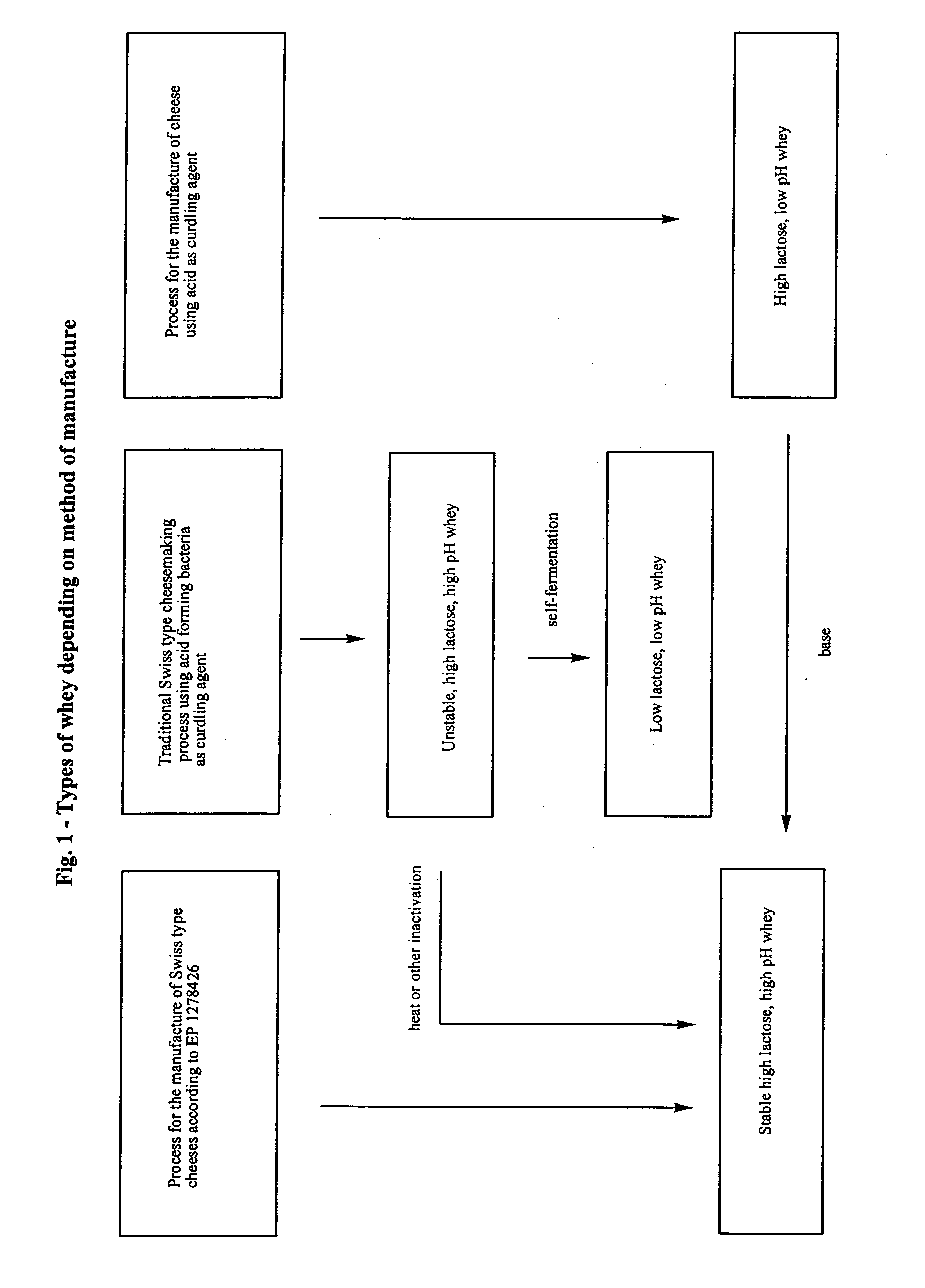Use of high lactose, high ph whey in the preparation of milk products
- Summary
- Abstract
- Description
- Claims
- Application Information
AI Technical Summary
Benefits of technology
Problems solved by technology
Method used
Image
Examples
example 1
Preparation of a Milk-Like Product Made from Standardised Milk and Stabilised, High Lactose, High pH Whey
[0091]This example illustrates the preparation of milk-like products having a standardised protein content of 3.5% and varying fat content corresponding to whole milk, semi-skimmed milk and skim milk respectively.
[0092]Danish Jersey milk having a fat content of 5.5% and a protein content of 4% and stabilised, high lactose, high pH whey are used as starting ingredients. The whey contains approximately 20% of the total protein content of the Jersey milk (approximately 8 g / litre) and approximately 0.05% fat.
[0093]In order to determine the amount of whey necessary in the standardisation in order to obtain a product having a protein content of 3.5%, equation (4) above is used is used:
X=(protein-%dilutent−protein-%product) / (protein-%dilutent−protein-%whey)=>
X=(4.0−3.5) / 4.0−0.8)=>X=0.15625.
[0094]Hence in order to obtain a product having a desired protein content of 3.5%, 15.625% of the ...
example 2
Preparation of a Milk-Like Product Made from Raw Milk and Stabilised, High Lactose, High pH Whey
[0104]This example illustrates the preparation of milk-like products having low protein content and varying fat content corresponding to whole milk, semi-skimmed milk and skim milk respectively. The product is obtained by mixing stabilised, high lactose, high pH whey and raw Jersey milk. Danish Jersey milk having a fat content of 5.5% and a protein content of 4% and stabilised, high lactose, high pH whey are used as starting ingredients. The whey contains approximately 20% of the total protein content of the Jersey milk (approximately 8 g / litre) and approximately 0.05% fat.
[0105]Using equation (3)
X=(fat-%dilutent−fat-%product) / (fat-%dilutent−fat-%whey) (3)
[0106]And substituting fat-%dilutent=5.5%; fat-%whey=0.05%; fat-%product=3.5% (whole milk), 1.5% (semi-skimmed milk) and 0.1% (skimmed milk), gives the ratio X in respect of to whole milk, semi-skimmed milk and skim milk respectively:
Wh...
example 3
Preparation of a Whole Milk-Like Product Made from Cream and Stabilised, High Lactose, High pH Whey
[0111]This example illustrates the preparation of a whole milk-like product having a low protein content and a fat content corresponding to whole milk (3.5% fat). The product is obtained by mixing stabilised, high lactose, high pH whey and cream made from Jersey milk. The cream has fat content of approximately 37% and a protein content of approximately 0.7%.
[0112]The stabilised, high lactose, high pH whey contains approximately 20% of the total protein content of the Jersey milk (approximately 8 g / litre) and approximately 0.05% fat.
[0113]Using equation (3) above and substituting the appropriate numbers reveals that the amount of stabilised, high lactose, high pH whey must amount to 90.7% of the product. This corresponds to a protein content of the product of 0.79%.
Procedure
[0114]The whole milk like product is made by mixing the stabilised, high lactose, high pH whey with cream in a mix...
PUM
 Login to view more
Login to view more Abstract
Description
Claims
Application Information
 Login to view more
Login to view more - R&D Engineer
- R&D Manager
- IP Professional
- Industry Leading Data Capabilities
- Powerful AI technology
- Patent DNA Extraction
Browse by: Latest US Patents, China's latest patents, Technical Efficacy Thesaurus, Application Domain, Technology Topic.
© 2024 PatSnap. All rights reserved.Legal|Privacy policy|Modern Slavery Act Transparency Statement|Sitemap


